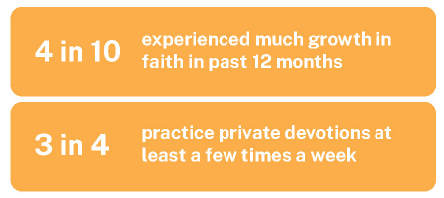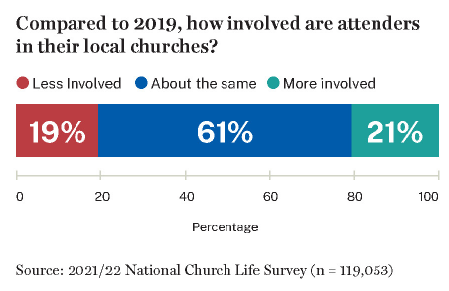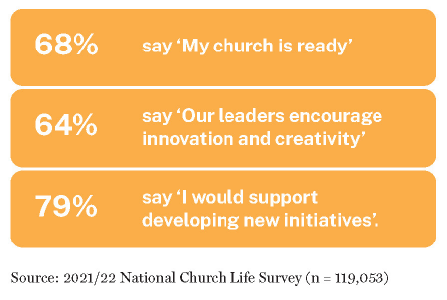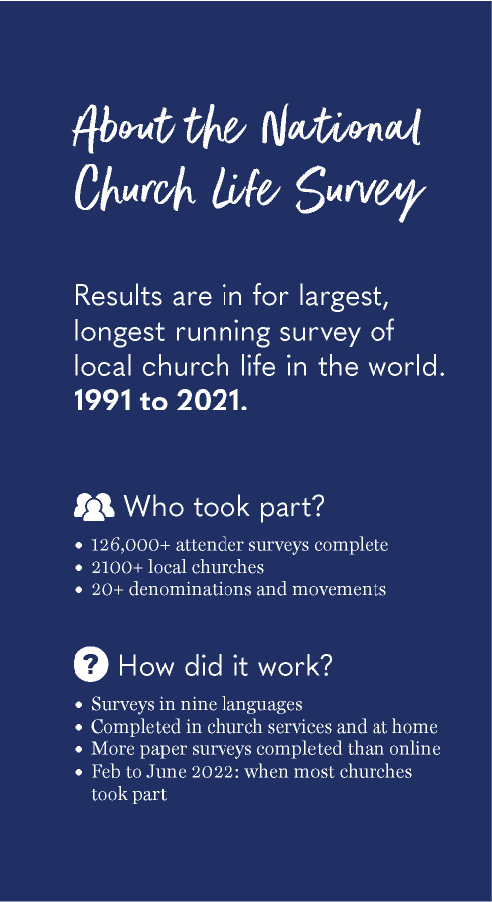The 2021-22 National Church Life Survey may be the most important ever run. In an era of COVID-19, church life was impacted. Leaders needed to listen to their churchgoers more than ever.
So what did our survey find?

Churchgoers seek community and spiritual growth as priority
Now you are the body of Christ, and each one of you is a part of it. (1 Cor. 12:27)
Building community is top priority Australian churchgoers highly value the community they find in their local churches. Latest results from the National Church Life Survey found that 87% have a strong sense of belonging, and 79% have found it easy to make friends.
The negative impact of COVID is highly likely to be why attenders chose ‘a strong sense of community’ as their top priority for their local church in the coming 12 months.

Nurturing spiritual growth remains critical
There are many ways to find community, and the 11,400 churches around Australia play a vital part. However, local churches offer more than simply a way to connect with others. They are communities of faith. People share in common their journeys of faith as followers of Jesus Christ.
“Spiritual growth” was the other key priority that attenders identified for their churches. Some 41% of attenders agreed that they had experienced ‘much growth’ in faith in the past 12 months, a drop from 47% in 2016. It was a season where it was harder for local churches to provide sustained faith nurture. Yet, in challenging and disconnected times, three quarters of all church attenders continued
with private devotional practices at least a few times a week (53% do so on a daily basis).

How COVID impacted on church involvement
We have heard anecdotes that suggest COVID may have disrupted long-term habits of many churchgoers. While we don’t know the full impact yet, we do have some initial clues.
In the National Church Life Survey, church attenders were asked: “Compared to 2019 (before COVID), are you more or less involved at this local church?” Results found a solid committed core of around 6 in 10 church attenders with 4 in ten who are changing their engagement. Two in ten are more involved, while two in ten are less involved.

Attenders were also asked if they attended church elsewhere. Around six in 10 attenders only attend one church. However, four in 10 say they also attend elsewhere, in person (26%) or online (17%).
These results vary significantly by denomination, with more than half of Catholics attending Mass at more than one place. However, around a quarter of Protestants also reported attending other churches (15% attending in person, and 15% online).

Most attenders look forward with hope and confidence
Healthy churches have vital leadership and directions for the future. When a local church community shows a readiness to act or a culture of ‘collective confidence’, other signs of health are often present.
Committed and confident? Around six in 10 attenders are aware of a clear vision for the future and remain strongly (34%) or partly committed to it. Around three quarters (76%) of all church attenders are either fully or partly confident that their local church can achieve its vision, goals or directions. Not surprisingly, the levels of full confidence have slipped in the past 5 years from 48% in 2016 to 44% in 2021/22.
Attenders are open to new possibilities. Heathy churches are open to innovation. Our research has confirmed this characteristic in many different studies. Looking forward, we asked attenders to respond to three different questions. Did they think their local church was open to new possibilities? Did they think their local church leaders encouraged innovation and creative thinking? Finally, would they, personally, support the development of new initiatives?

Surely it couldn’t be done. How do you run a national survey across thousands of local churches in cities and towns across the nation in the middle of a pandemic?
Our NCLS Research team have been running the National Church Life Survey every five years at the same time as the National Census, but this time has been the hardest challenge yet. How can a survey be used to hear the experiences of churchgoers, and local church leaders in the midst of such disruption? Some states were in lockdown and many churches weren’t even meeting together. Survey projects in other countries were put on hold.
Yet, we have done it - together! Over 126,000 people in more than 2100 local churches in 20 plus denominations and movements took part.
Surveys in nine languages, customised for different groups, were offered in both paper and online formats. People gave their insights about on faith and church life gathered together and on their own, in churches, in parks, and in homes. (By the way, more people completed paper surveys than online).
Why did we persist? Church leaders told us they felt blinded, and that this could be the most important National Church Life Survey ever run to understand what was happening in local churches. The news from survey results may be tough, but as leaders said to us. “Now is not the time to bury our head in the sand. We need to know what has changed so we can respond in informed and helpful ways.”
So, THANK YOU to all those who put the hard work into making it happen. Your persistence and patience have been incredible. You have been part of the largest, longest running survey project of local church life in the world. As a research team, we are humbled and grateful.
Dr Ruth Powell,
Director for the NCLS Research team



